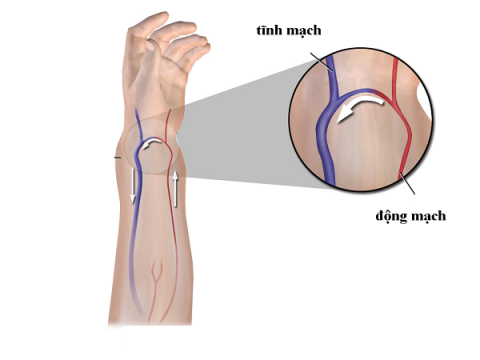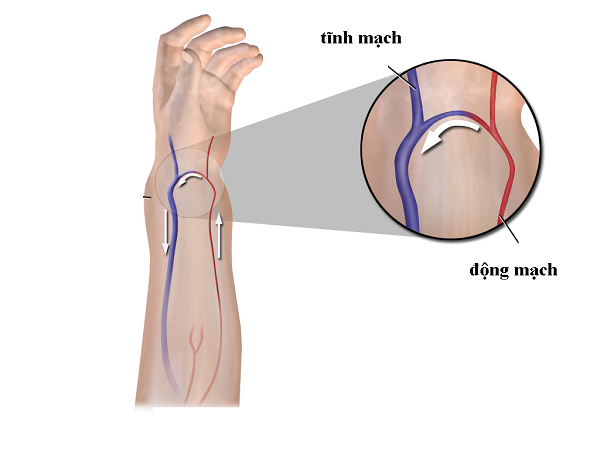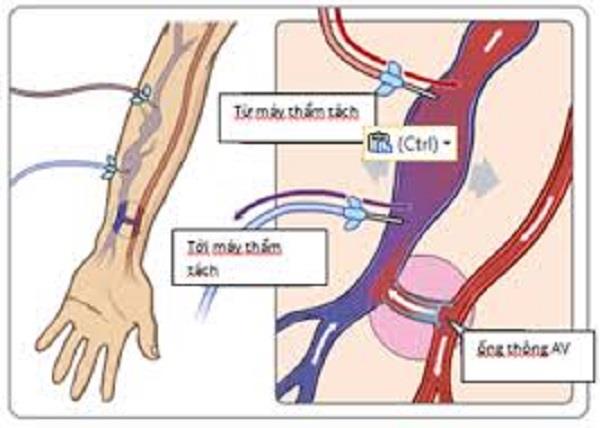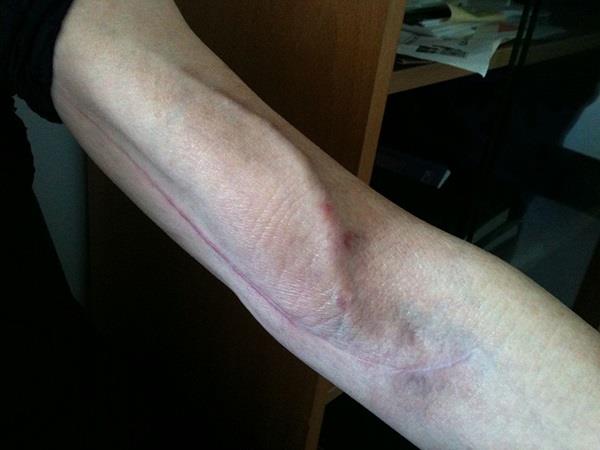Arteriovenous fistula: Understanding for proper handling!

The circulatory system is made up of the heart, blood vessels: arteries, veins and capillaries. Arteries carry blood from the heart to the organs to exchange oxygen and nutrients. This process occurs in the capillaries. After metabolism, nutrient-poor blood from the capillaries is absorbed into the veins. Blood from the static will be transported back to the heart to complete the circulation. This process takes place continuously, completely to ensure the functioning of the body. This article deals with the pathology of Arteriovenous Fistula. This is a disease caused by an abnormal connection between an artery and a vein. The disease can cause many serious consequences, especially if it is a large vascular anastomosis.
content
- 1. What is an arteriovenous fistula?
- 2. What is the cause of arteriovenous fistula?
- 3. Risk factors for arteriovenous fistula
- 4. What are the complications of arteriovenous fistula?
- 5. What are the symptoms of an arteriovenous fistula?
- 6. How to diagnose arteriovenous fistula?
- 7. How to treat arteriovenous fistula?
1. What is an arteriovenous fistula?
- An arteriovenous fistula is an abnormal connection between an artery and a vein without passing through a capillary. Fistulas may be congenital or the result of another process.
- Blood flow through the fistula reduces the amount of blood entering the capillaries. The first consequence is the lack of nutrients in the underlying organs. Long-term abnormal blood flow puts pressure on blood vessels, damaging them. More dangerous, it can also cause immobility abnormalities, causing many serious consequences.

2. What is the cause of arteriovenous fistula?
-
Congenital arteriovenous fistula.
Some people are born with a venous fistula (congenital). Although the reason is unclear, in congenital arteriovenous fistulas do not develop in the womb. That is, only when born does it manifest.
-
Hereditary disease.
A pulmonary venous fistula can be caused by an inherited disease (Osler-Weber-Rendu disease). Causes abnormal arteriovenous anastomosis in your body, especially in the lungs.
-
Penetrating trauma.
An arteriovenous fistula can also develop after a penetrating injury. Such as a bullet or stab wound. This can happen if the wound penetrates where a vein and artery meet.
-
Complications of cardiac catheterization.
An arteriovenous fistula can develop as a complication of a cardiac catheterization procedure. During a cardiac catheterization, a catheter is inserted into an artery or vein in your groin, neck, or arm and threaded through your blood vessels to your heart. If the needle goes through an artery and vein, this can create a fistula. Although it is a rare complication, it is still possible.
-
Arteriovenous anastomosis surgery.
This is a necessary procedure in patients requiring dialysis, dialysis, using artificial circulation… For example, patients with end-stage renal failure need multiple dialysis. If the dialysis needle is inserted too many times into the vein, the vein can scar and be destroyed. It is necessary to create a passage. This fistula is usually created in the forearm or thigh.

Arteriovenous anastomosis
3. Risk factors for arteriovenous fistula
Genetic or congenital conditions are unavoidable risk factors. Additionally, a fistula in a vein can increase due to certain factors, including:
- Cardiac catheterization, especially if the procedure involves blood vessels.
- High blood pressure (hypertension). Some arteriovenous anastomosis at birth degenerate into fibrous form. However, if blood pressure is continuously high, it will put pressure on this passage to widen.
- Fat
- Certain medicines, including some blood thinners (anticoagulants) and medicines used to control bleeding (anti-fibrinolytics).
- Elderly
- Woman
4. What are the complications of arteriovenous fistula?
Left untreated, an arteriovenous fistula can cause complications, some of which can be serious. These include:
- Heart failure. This is the most serious complication of large arteriovenous fistulas. Arteriovenous shunts cause hemodynamic abnormalities. Specifically, blood returns to the heart faster, peripheral blood pressure is lower.. Over time, increasing the intensity of the heart's work can weaken the heart muscle, leading to heart failure.
- Create a blood clot. An arteriovenous fistula in the leg can cause blood clots. Deep vein thrombosis can be life-threatening if it causes a pulmonary embolism. Depending on where the fistula is located, it can also lead to a stroke.
- Footsore. A fistula in the leg can also cause you to develop pain in the leg.
- Bleed. Arteriovenous fistulas can lead to bleeding, including into the digestive system.
5. What are the symptoms of an arteriovenous fistula?
Manifestations of arteriovenous fistula vary widely depending on the location of the fistula. Small fistulas will usually not have any signs or symptoms. Large arteriovenous fistulas can cause signs and symptoms, and even be dangerous. Symptoms may include:
- Purple luster, swollen veins that you can see through the skin, similar to varicose veins
- Swelling in arms or legs

- Hypotension
- Tired
- Heart failure
An arteriovenous fistula in the lung is a serious condition and can cause:
- Pale, pale skin
- Delicious drumsticks
- Hemoptisi
Arteriovenous fistula in the gastrointestinal tract can cause bleeding in the gastrointestinal tract
6. How to diagnose arteriovenous fistula?
Diagnosis of arteriovenous fistula requires a combination of history, medical history, clinical examination and laboratory tests. The doctor uses a stethoscope to listen to blood flow through the area where the fistula may be. Blood flow through the fistula makes a sound called a murmur.
If your doctor suspects a fistula, other tests will be done to confirm the diagnosis. They may include:
- Doppler ultrasound of blood vessels. Ultrasound is the most effective and common way to check for an arteriovenous fistula. Especially easy and economical if the fistula is in the blood vessels of the leg or arm.
- Computed tomography (CT) of blood vessels. A CT angiogram allows your doctor to examine your arteries through images. The vascular system is visualized through the contrast agent injected into the bloodstream.
- Magnetic resonance angiography (MRA). Magnetic resonance angiography is used to investigate when the fistula is deep in the body. Especially the fistula located around the soft tissue is difficult to diagnose. It uses the same technique as magnetic resonance imaging (MRI), but also includes the use of a special dye that helps create images of blood vessels.
Depending on the clinical condition and symptoms of the patient, the doctor will give appropriate tests.
7. How to treat arteriovenous fistula?
Small, asymptomatic fistulas usually do not require treatment. If the arteriovenous fistula is large, the following treatments are usually available:
- Ultrasonic compression of the fistula. Fistulas in a vein in the leg and easily seen on ultrasound can be treated with compression ultrasound. In this treatment, an ultrasound probe is used to compress the fistula. This in turn blocks blood flow to the damaged blood vessels. This procedure only takes about 10 minutes. But it has a low success rate, about 1 in 3 people.
- Place a stent to block the fistula. The doctor will insert a stent into the artery at the site of the fistula to cover it. This helps impede the flow of blood through the fistula. However, this method carries a risk of blood clot formation at the stent site.

Stent
- Surgery. If the above methods fail or are contraindicated, surgery should be considered. The type of surgery you will need depends on the size and location of the fistula.
Arteriovenous fistula is a relatively rare vascular disease. The disease can be silent, but it can also have serious complications. Fistula can be completely treated without any consequences if handled correctly. Monitoring disease manifestations, timely detection and proper treatment is the way to overcome effectively.
Doctor Luong Sy Bac